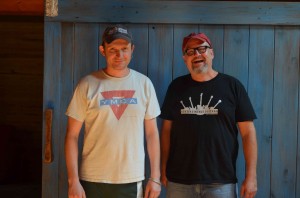I had to be talked into recording The Edge of America.
Not that I didn’t want to. I just felt that I couldn’t afford it and/or shouldn’t be spending that kind of money on a venture that would never pay for itself.
Jefferson Ross, a songwriter from Nashville living in Savannah for a few years, talked me into it. In two ways.
One, he swore it wasn’t as expensive as it once was, and his producer, a close friend, would make me a deal I couldn’t refuse.
But secondly, he challenged me as a songwriter. He flat out said: If you are a real artist, and not some pretender, then you have to record these songs. It’s your obligation; it’s your legacy. It doesn’t matter in the long run whether it pays for itself.
So I called Thomm Jutz in Nashville. Thomm has written for and recorded Kim Richey, Irene Kelley and Nanci Griffith.
I could tell Thomm immediately understood my concept for this CD. Here’s what I later emailed Thomm: “What I’m looking for is simplicity. Something that sounds genuine. Real. Perhaps a bit raw vs. perfect. More live than studio.
“I don’t want it to sound like some guy ran up to Nashville, got some brilliant studio musicians and a rubber stamp producer to knock his simple little songs out in record time,” I wrote. “I’ve heard some of those. Slick with no heart.”
He agreed, saying we would seek something “fairly simple, stripped down, live sounding that would be killer.”
We actually did get some brilliant musicians: Mark Fain on bass, Lynn Williams on drums and Terry Crisp on my favorite instrument, pedal steel. (If you’ve heard the CD, you know that Terry basically steals the show.)
Mark has played with Marty Stuart, Ricky Skaggs and Martina McBride.
Likewise, Terry’s credits include work on the albums of Ricky Skaggs, Marty Stuart, Dolly Parton and Reba McEntire.
Lynn has played with Delbert McClinton, Bonnie Bramlett, Leroy Parnell and Grammy nominee Marcia Ball.
They were so nice, friendly, easy to work with and unbelievably professional. Not only did they get the songs quickly — like at first reading of the charts (the equivalent of sheet music in Nashville) and hearing only a few bars — but they killed them.
It would have been easy for them to phone it in, but on more than one song, one of them would ask to redo his part because he thought he could do something better. Sounded great to me the first time.
Thomm added lead guitar on the six songs the boys cut. On four others, it’s Thomm’s guitar playing that makes the music. My rhythm guitar playing is in there somewhere, but probably muted most of the time!
Here’s how we did it.
I was in one room; Lynn in another. Terry was set up in the control room with Thomm, and Mark was in the closed off hallway with his standup bass.
We all had headphones, with Thomm counting off: One, two, three, four….
Most were done in one take, except on a few songs, as I said, one of the musicians would go back over a part of his track.
The next day, I redid some of the vocals. And then Thomm and I recorded the four with just he and me.
On the last day, before I headed home, I sat alone and knocked out “The Ballad of Tybee” in one take. It’s a little rough, but that’s ok. It was as I asked for: real.
The best compliment I could give Thomm was written by my friend and fellow musician John Wynn after he’d heard the CD: “I’ve (heard) learned the songs in other ways and contexts, but as I listen to them here I have to say that this, it seems to me, is exactly how they should be done.”
If you are interested in receiving email alerts about new postings on this site, please sign up below.
/Users/thomasoliver/Downloads/signature.png

